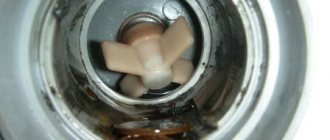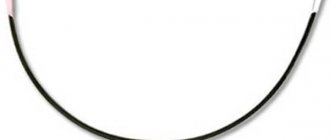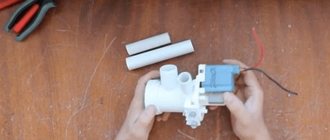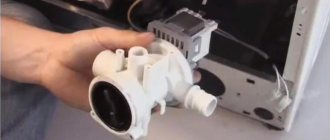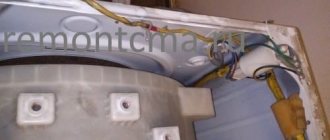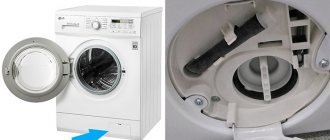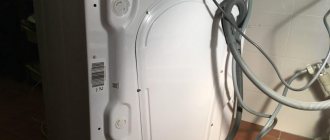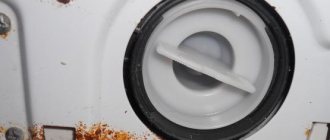- Checking the pump volute
- How to check the functionality of a washing machine pump
- How to check a washing machine pump with a multimeter
- Mechanical check
- Replacing a washing machine pump
Depending on the signs of breakdown, we use one of four ways to check the washing machine.
- The machine does not drain water
- Extraneous sounds and noise are heard
- The pump hums and does not pump
- The drain pump does not work and there are no sounds.
The test should be carried out according to the principle “from simple to complex.” First we check for blockages.
It is advisable to check without removing the drain pump from the washing machine. This will save time and effort if another cause of the problem is discovered. Some machine models are quite complex in design and if you are not used to it, it will be quite difficult to even get to the pump.
Checking the pump volute
If you hear an unusual noise in the area where the pump is located (the lower right side of the machine), then perhaps a small object has gotten into the pump volute after washing or a critical blockage has occurred. If this happens during the washing process, you will first have to empty the water from the drum. The check is as follows:
- Open the cover in the lower right part of the panel.
- We see a round hole with a plug - this is a filter.
- We open the filter by unscrewing it. Water leakage is possible, so we will place a small flat container in advance.
- We look inside the cochlea cavity (you can illuminate it with a flashlight), remove foreign objects if they are there. In normal condition, we will not see anything other than the pump impeller. Except in cases where two motors are installed on one snail - one for draining, the other for recirculation (watering).
Another traditional reason is a clogged inlet pipe. Purely mechanical cleaning will help.
Why doesn't the washing machine drain water?
Most likely the reason is in the drain pump and it is this that we will change in this article, but first I recommend doing the following manipulations. Carefully inspect the drain hose for possible kinks. Then it would be a good idea to look into the washing machine pump filter. Next, you need to try to rotate the pump impeller; sometimes small objects jam it. Unfortunately, not all washing machines have a filter. And finally, check the connection between the drain and the sewer, it may be clogged. If there is no result, then we move on to active hostilities.
Before dismantling the filter, you need to place a basin to drain the water. If the filter is clogged, you need to clean it and put it back.
| Cleaning the drain pipe |
If the filter is pulled out of the housing and the remaining water still does not leave the tank, then the pipe located from the tank to the pump is clogged. To gain access to it, you need to unscrew the fastening screws of the drain assembly (volute). After disconnecting the snail from the machine body, it is necessary to loosen and pull out the clamp securing the pipe, and direct the end of the pipe into a basin to drain the water. If water does not flow, feel the corrugated hose for the possible presence of large foreign objects; if found, remove them. Then screw on the clamp and assemble the entire assembly in reverse order.
| Impeller wedge - washing machine does not drain water |
Try turning on the water drain mode. If you hear a slight hum, but the water still does not drain, turn it off quickly and do not load the pump. The hum indirectly hints that the drain pump impeller may be jammed.
We turn off the device from the mains and drain the water manually; to do this, simply position the drain hose below the level of the tank, and the impeller wedge will not interfere with draining water into any container.
If the pump pipe and filter are working properly, but the water still does not drain, you will have to check the rotation of the pump impeller.
She hides right behind the filter. The presence of any foreign object in it (buttons, coins, etc.) can cause it to jam. If you find a foreign body, simply pull it out.
In order to gain access to the impeller, you need to remove the plug with the filter (see picture above) and clean it of various accumulated debris.
After cleaning and rotating the impeller with your fingers, make sure that the wedge disappears. But keep in mind that it will not rotate very easily, as it is held in place by a magnetic field.
| Checking and replacing the drain pump |
The pump is checked last. To do this, with the filter removed, turn on the “Spin” mode and shine a flashlight into the hole for the filter. If the impeller is not blocked but does not move, then the pump is faulty and needs to be replaced.
We are disassembling the washing machine; it is advisable to look at the service instructions before doing this. Then you need to check with a multimeter the presence of 220 volts at the terminals of the drain pump. If it is present, and the pump hums and heats up, then anyway it needs to be changed. You can also ring the pump winding whose resistance is usually 140-180 Ohms.
If there are no 220 volts, and the washer still does not drain water, then most likely the problem is in the electronic control module or some trouble in the pump power circuit; a tester will help you.
We only remove the engine and leave the snail alone; the design of your pump may differ from what is shown in the picture. This is exactly what you should buy, the cut can be similar, but make sure that the fastening and power of the pump match. The pump type and its number for remote ordering can also be found in the diagram or in the service documentation
| Replacing the drain hose - the washing machine does not drain water |
Even this simple replacement requires access inside. From the pump, the drain hose runs along the inner wall and is discharged outside at the top or bottom of the housing, depending on the model.
Relevant for SM Siemen, Bosch and AEG
.
How to check the functionality of a washing machine pump
In the illustration: a view of the washing machine from below, the drain pump feature is disabled. 2 more pumps are visible (recirculation and watering).
Attention! When working with electrical devices, you must follow safety regulations!
If the pump does not drain water, then in order to check its functionality and eliminate suspicions of a malfunction of the electronic module, we proceed in the following way:
- After washing, leave water in the tank or add water so that the water level is slightly above the bottom of the drum.
- We disconnect the washing machine from the network by removing the plug from the socket.
- We remove the front panel of the machine to have access to the pump connection terminals.
- We will remove the chip or terminals, depending on the features of the model. We connect the terminals of the pre-prepared wire with a plug. We check the reliability of the fit and the absence of mutual contact between the contacts. We plug the plug into the socket. If the water in the tank leaves, it means the pump is in working order. And the cause of the breakdown must be sought in a malfunction of the electronic module or other elements in the pump control circuit.
Rules for the operation and prevention of the washing machine
To ensure that your washing machine serves trouble-free for many years, we advise you to follow some simple recommendations:
- Each washing machine model is designed for a certain weight of laundry loaded into it. If this weight is exceeded, the unit will wear out. In this case, the likelihood of failure increases many times over.
- There is always some kind of garbage in the pockets of the laundry loaded into the tank. These could be pins, paper clips, coins, headphones, pieces of paper, etc. Any of them can damage the pump, impeller, or motor. Remember to inspect all clothing before loading.
- It is better to connect the machine to the power supply not directly, but through a special surge protector. It smoothes out voltage surges, which are not uncommon in our networks. Small jumps are not harmful to the washing machine, since this is provided for by its design, but large differences can lead to damage to the electronic unit.
- Do not forget to regularly clean the filter located under the hatch on the front wall. This should be done annually, or even better - every 6 months. If the filter is clogged, this may be one of the reasons why the washing machine does not drain water.
- Before starting washing, carefully set the required mode.
- Carry out preventive cleaning of the machine every year without laundry. To do this, you need to load the powder and descaling agent, set the highest temperature and carry out a full wash cycle. As a result, scale and dirt will be removed.
By using these simple tips, you will be able to use your washing machine for its intended purpose for many years.
How to check a washing machine pump with a multimeter
The third way to check is to test the pump motor winding. The nominal winding resistance of any type of pump should be in the range of 150-260 Ohms. Let's turn off the power to the machine. Remove the pump connection contacts. We turn the multimeter into resistance measurement mode and touch the motor contacts with the probes. Readings at zero level will tell us about a short circuit, and readings of an infinitely large value indicate a break in the winding. And also a significant deviation from the nominal values indicates a malfunction of the stator winding. In this case, the entire pump of the washing machine needs to be replaced, because... repairs turn out to be simply unprofitable, and in some cases completely impossible. This test must be completed with a test with a direct connection to 220.
Cleaning the pump of the Indesit washing machine and other models
The impeller in the drain pump is cleaned, so it must be removed from the pump. To do this, unscrew several screws located on the pump body and connecting its two parts. The impeller rotates when in working order. As a rule, objects in the form of threads, wool, and fibers are wound around it. All these foreign objects are carefully removed. Then you need to clean the inside of the snail. After these procedures replace the pump, the machine is assembled in the reverse order. After assembling the equipment, washing starts in test mode, that is, without laundry. Its purpose is to find out whether the noise has been eliminated, whether there is a leak, and whether it is being drained.
If the procedure for cleaning the drain system does not lead to a positive result, the solution is to replace the old pump with a new one.
Why does the drain pump become clogged?
There are three main reasons:
- Hard and dirty water.
- Foreign objects falling into the laundry drum.
- Poor quality detergents.
Following simple but important rules for operating washing equipment will help prevent pump failure.
Mechanical check
For a mechanical check, remove the snail. In this case, the movement of the impeller and the wear of the bushings are checked. Let's turn the impeller manually. In a normal state, its rotation occurs intermittently, as if in jerks. This is due to the rotor made of a permanent magnet. Next: shake the impeller from side to side across the axis. If there is significant play, it is time to replace the drain pump. If all the signs are normal, the last check is to connect the motor directly to the network using a pre-prepared wire with two terminals and a plug. The motor should start without any extraneous noise.
Verification Process
Both the electrical and mechanical parts of the pump can fail. Many home craftsmen, forgetting about mechanics, rush to check the electrics, armed with a tester. But often the pump stops working due to debris.
Unfortunately, not all the debris goes into the drain filter - some of it can collect in the impeller area. Most often, hair and threads get wrapped around it, blocking the work over time. If you are thinking about how to check the pump without removing it from the engine, then we recommend removing it, especially since it is very easy to do:
- Take a photo or video of the wiring location. This will help you connect everything back correctly later.
- Remove the wiring.
- Unclench the clamps of the pipe and hose using pliers. Don't break them - they will be useful again.
- Turn the pump half a turn to the left and remove the part without any effort.
Related article: How to remove odor from a washing machine
Before disassembling the pump, carefully inspect the impeller. If you notice debris blocking its operation, start cleaning it. Be sure to thoroughly clean the entire pump to remove any accumulated dirt. Mechanics also include gaskets - they can wear out.
Important! Service centers do not advise repairing the pump, suggesting that it be replaced immediately. But the “traditional craftsmen” came up with a more economical way. They know how to lubricate the washing machine pump and use lithol or graphite lubricant.
If the mechanics are in perfect order, you can check the electrics. Proceed this way:
- Turn on the tester by selecting voltage test mode.
- Place the probes on the contacts.
- Does “0” or “1” appear on the display? The pump motor may have burned out - replace it.
- If a three-digit number lights up on the screen, then the problem may not be in the motor itself, but in the electronic control unit. More accurate diagnosis is required.
Now you know how to check the drain pump on a washing machine: disassembly is not essential, and checking will not take a lot of time. To make it easier, watch the video:
We will tell you how to properly check the pump in a washing machine, which will help you protect yourself and your assistant from a huge number of different breakdowns, and learn how to find and fix breakdowns of this nature yourself.
Replacing a washing machine pump
In the best case, of course, replace it with exactly the same one. But if the original cannot be found, then an analogue is selected based on the characteristics.
A replacement pump is selected based on the following criteria:
- Electrical power in watts.
- Method of fastening the snail: latches or self-tapping screws.
- Number of latches or fastening points for screws.
- Electrical connection: chip or terminals - together or separately, front or rear.
Pumps of Chinese and Italian production Leili, Askoll, SKL, Copreci are interchangeable - subject to the characteristics and characteristics.
Is it difficult to change a part?
You can replace the pump of a Samsung washing machine yourself. It is important to select a replacement element that fully matches the standard one. When the original cannot be found, an analogue can be installed.
When choosing a pump, you need to focus on the following characteristics:
- power;
- snail fastening method;
- number of latches or mounting holes for bolts;
- connection method (chip or terminals).
The pump replacement algorithm is as follows:
- disconnect the two power wires going to the pump by removing the terminals;
- unscrew the bolts securing the pump to the volute;
- remove the pump from the housing;
- connect the new pump to its original place in the same position, secure it with self-tapping screws;
- connect terminals, wiring;
- place the SMA in its original position;
- Screw in the garbage filter and close the protective hatch.
Afterwards, you can connect the machine to communications, plug it in and start a test wash. Thus, it is possible to diagnose and replace the drain pump at home, without calling a technician. It is important to strictly follow the rules and instructions for action.
Interesting:
- How to repair a Samsung washing machine
- Rating of Samsung washing machines
- Samsung washing machine - spinning and draining does not work
- Washing machine pump repair
- DIY LG washing machine pump repair
- Samsung washing machine pump repair
Reader comments
- Share your opinion - leave a comment
